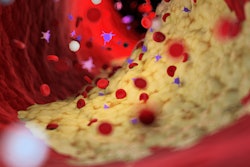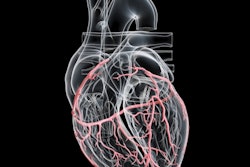
A vendor-neutral CT coronary artery calcium (CAC) score calibration tool shows promise for improving heart disease risk assessment, according to a Journal of the American College of Cardiology: Cardiovascular Imaging study.
Developed by a group led by Niels van der Werf, PhD, of the University Medical Center Utrecht in the Netherlands, the score calibration tool demonstrated clinical value when tested on CT exams from the Multi-Ethnic Study on Atherosclerosis (MESA).
"MESA participants who were reclassified to a higher calcium category by means of the [calibration tool] experienced more coronary heart disease events, indicating improved risk categorization," the authors reported.
CAC scores can vary across CT systems, which can complicate heart disease risk assessment, according to the authors.
"Substantial variation in Agatston scores acquired with different computed tomography scanners may influence patient risk classification," the group noted.
In the 1990s, researchers began to use electron beam tomography (EBT) for CAC assessment. CT has now replaced this for the most part, but current CAC assessment frameworks are based on studies that used EBT. Previous studies have shown that CT CAC measurements improve risk assessment for both coronary heart disease and atherosclerotic cardiovascular disease in asymptomatic patients; it is done using the Agatston scoring method, which calculates the amount of plaque identified on CT.
But scoring can differ across CT systems, which is why there is a need to calibrate scores, van der Werf's group explained.
"Clinically, variations in Agatston score may translate into risk misclassification and improper treatment in up to 6.5% of asymptomatic individuals," the team wrote.
To address the problem, van der Werf's group developed a CAC score calibration tool, using two phantoms containing calcium with seven different CT and one electron-beam tomography (EBT) system (the latter of which was used for reference). The team then conducted a study that included data from 3,181 MESA participants who underwent CT exams, comparing coronary heart disease event rates between low calcium (Agatston score of less than 100) and high calcium groups (Agatston score equal to or greater than 100).
The calibration algorithm reclassified 85 low-calcium patients (11%) to a higher-risk category, and the coronary heart disease event rate in this cohort was 15% higher for these individuals compared to low-risk patients who were not reclassified (7%). The coronary heart disease hazard ratio for reclassified low calcium patients was 3.39 (reference, 1).
There's no doubt that CAC evaluation is crucial for patient care, according to van der Werf and colleagues.
"CAC evaluation is not only important for initial risk stratification but also in follow-up analysis ... [as previous research has shown] CAC progression [is] more pronounced in patients with coronary heart disease events than in those without events," they concluded.
The study was published on June 14 and can be found here.





















